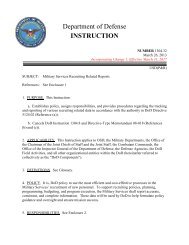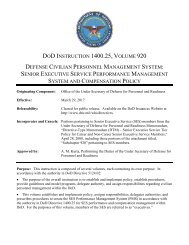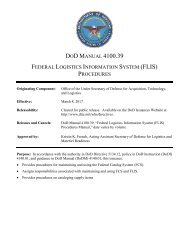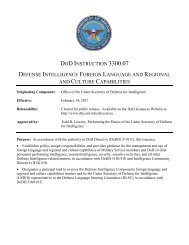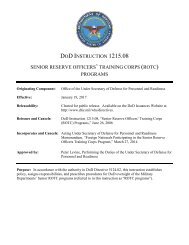520045m
520045m
520045m
You also want an ePaper? Increase the reach of your titles
YUMPU automatically turns print PDFs into web optimized ePapers that Google loves.
DoDM 5200.45, April 2, 2013<br />
could reasonably be expected to cause some degree of damage to national security.<br />
Subparagraphs 3.a.(1) through 3.a.(10) lists some basic considerations, but they are not allinclusive.<br />
(1) In general, resource information should not be classified unless it reveals some aspect<br />
of the intelligence mission, and its revelation would jeopardize the effectiveness of a particular<br />
function. An example of classifiable resource information is the intelligence contingency fund.<br />
(2) Intelligence concerning foreign weapons systems is typically classified based on<br />
what is generally known about a particular system or its components. Normally, the less that is<br />
known publicly about a particular system or component the higher its level of classification.<br />
(3) Intelligence identifying a sensitive source or method should always be classified, as<br />
should be the evaluation of the particular source or method.<br />
(4) Intelligence that does not identify or reveal a sensitive source or method is usually<br />
not classified unless the information contains other classified information such as intelligence<br />
activities including intelligence plans, policies, or operations.<br />
(5) Intelligence that reveals the identity of a conventional source or method normally<br />
does not require classification. However, if the information is communicated to the DoD by a<br />
foreign government, whether under a formal government-to-government agreement or simply<br />
with the understanding that the information is provided in confidence, the information must be<br />
protected at the level and for the length of time agreed to by the U.S. Government and the<br />
foreign government. If the information is obtained from a foreign government without any<br />
agreement or restrictions, the classification, if any, should be based solely on the content of the<br />
information provided.<br />
(6) Intelligence that reveals known and possible enemy capabilities to collect and exploit<br />
information from a given or similar operation should be classified. This would include enemy<br />
intelligence collection and analysis capabilities, efforts, and successes.<br />
(7) An intelligence estimate is normally classified since it is likely to contain sensitive<br />
sources or methods, and/or raw or evaluated intelligence.<br />
(8) An intelligence requirement should be classified when it reveals what is not known,<br />
what is necessary to know, and why. Moreover, the requirement may recommend a sensitive<br />
source or method, other military intelligence required, or contain technical and operational<br />
characteristics of classified weapons systems.<br />
(9) The classification of relationships with foreign intelligence organizations is related to<br />
the considerations in subparagraphs 3.a.(9)(a) through 3.a.(9)(d):<br />
(a) Normally, the fact of broad, U.S. general intelligence cooperation with foreign<br />
countries or groups of countries with which the United States maintains formal military alliances<br />
or agreements (e.g., the North Atlantic Treaty Organization (NATO)) is not classified.<br />
34<br />
ENCLOSURE 3



